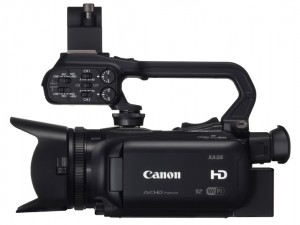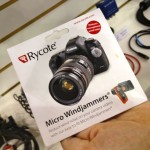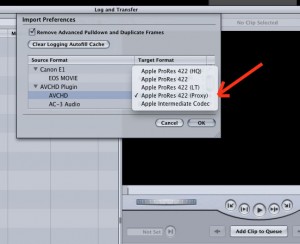Canon XA25 and XA20 promise new workflow choices
Canon has announced two new siblings for the XA10 camcorder. I’ve been using the small, budget friendly XA10 for a while and the new XA25 (with HDSDI jack) and the XA20 (without SDI) look like huge improvements.
First, they have a 20x lens instead of the 10x on the XA10. They have a new sensor which promises an improved image, including in low light. The XA10 was no slouch in the low light department so these should be great. It’s a tiny bit bigger chip but still roughly 1/3″ so don’t expect great things in the shallow-depth-of-field department.
But the really interesting thing about these new cameras for us news shooters is the WIFI built into the camera, combined with the onboard dual-memory-card, dual-codec, live-downrez recording. The camera records in AVCHD but will also record to MP4. And not only to MP4 but simultaneously downrez MP4 onto the second memory card. This is important because you can use MP4 files with iPads and for web use directly. So in theory you can handle all of your web streaming and instant video clip postings straight out of camera. Nothing in the release about in-camera editing, though.
And if you’re a control freak, you can operate the camera from your smart phone.
The release doesn’t mention any improvements on the audio quality, which was a weak point with the XA10 when using the mic level inputs. It does have XLR inputs on a detachable handle; line and mic switchable.
The XA10 is tiny and will run forever on an optional extra large battery.
B&H has the XA20 and XA25 on preorder for $2200 and $2700.
I will update this post when I get my hands on one Monday at NAB.
JVC GY-HM650 web and broadcast news cam
JVC is showing pre-production models of a news camera called the GY-HM650. This is a web-friendly broadcast-quality handy cam.
When it ships in December for $5695, it will have the ability to FTP from camera and be able to connect to wifi.
The magic here is that it has dual encoders that will let you record HD to one card and web-rez H.264 (among other codecs) to the other, and then send it out. But not live, unfortunately.
The HM650 does have both hdsdi and hdmi outputs so you can output live.
It’s got a 23X zoom with separate zoom, iris, and focus, and the camera has a decent grip. Big drawback seems to be small LCD and small EVF on the working HM600 they were showing. (HM600 lacks dual encoders and connectivity.)
This is a very interesting camera for news.
Black Magic Design $3k cinema camera
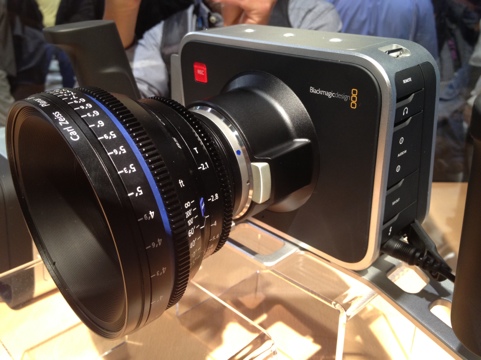
The Black Magic Design cinema camera is creating a huge buzz at NAB thanks to its low price of $2995.
It has only a Canon EF mount (not Nikon as erroneously put out in an early press release.) Mount is not interchangeable. Sensor is roughly Micro 4/3 size so your lens is doubled in focal length.
Has a 90 minute battery and a 12 volt input. Shoots avid dnxhd, prores and raw.
It’s cool but not a journalist’s camera.
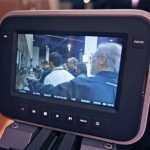
Audio gear from NAB 2012 for DSLRS and for iPhones
I’m going to round up a bunch of audio discoveries I found at NAB 2012. Some for dslrs and some for iphones.
(UPDATE: Rode is not at the show and no one here has their new VideoMic HD recorder/microphone yet, so sorry, no info on that.)
DSLR audio stuff
Que Audio: First off, the video above is recorded into a Sony NEX7 with a Que Audio mic. This mic is very tiny and will fit into your camera bag along with the rest of your gear and still leave room for lunch. It’s a shotgun mic that’s about the size of a pen yet sounds pretty good. They are packaged in a variety of kits, from a bare-bones mic with shock mount on up to kits with booms and stands. The video was shot in a very noisy convention hall but the voice is still clear.
Rycote: Rycote has three items that news shooters will be interested in. First is a shock mount for your H4N or Tascam DR40 recorder so you can put it on top of your camera and reduce the handling noise. In the company photos the mount looks big but I’m pleased to report it’s not so big in real life.
The next Rycote goodie is their Invision Video shock mount. This is designed to hold shotgun microphones, but it will also clamp onto your Sennheiser MKE400 mic, even after you’ve broken the little shock mount on it. This mount is a great solution to those little rubber legs breaking off.
And finally, a must-have accessory for your DSLR or your iPhone is the Rycote micro windjammer, which is a little dot of furry wonder to cut the wind noise from your built-in mics on your camera or phone. These are semi-disposable, and stick on with a little circular pad to cover the mic. These work.
iPhone audio: This is a new subject for most manufacturers, but several iPhone audio solutions were at NAB. First was from Mic-W, a Beijing-based company making iPhone mics for mobile journalists and musicians. They have a range of shotguns and lavs that plug directly into an iPhone. The video above was recorded into an iPhone 4s with a Mic-W lavalier mic while he talked about a shotgun mic that plugs directly into an iPhone.
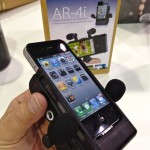 Fostex with the AR-4i has updated their microphone mount for iPhones so that it now works with an iPhone 4s – or at least that’s what the folks at Location Sound told me, as I didn’t get to try one. Your iPhone goes into this contraption and you get two external mics and a bunch of jacks.
Fostex with the AR-4i has updated their microphone mount for iPhones so that it now works with an iPhone 4s – or at least that’s what the folks at Location Sound told me, as I didn’t get to try one. Your iPhone goes into this contraption and you get two external mics and a bunch of jacks.
Canon’s baby cam: the XF100
Canon’s new XF100 and XF105 look like they’ll be great photojournalist’s cameras. Too bad about the 10x lens, though.
Using separate audio recorder with DSLR video
How-to: Shooting ENG style with Dual System Audio on a Canon EOS 5D Mark II from Createasphere on Vimeo.
Daniel Plym shows how he uses a separate audio recorder with Plural Eyes software to synch up separate audio while shooting video with a DSLR.
New Sony big-chip camera and new Vixia HF M32 announced
Two interesting new cameras:
1) Canon Vixia HF M32 is the next step in the tiny, AVCHD line of camcorders which keep improving with each new model. It will give 24 hours of recording to the built-in memory plus SDHC/SDXC memory cards. What makes this one interesting is that it has “Powered IS” image stabilizer, which is a hand-held miracle, and it has built-in downconversion to standard def while retaining the HD. Works with Eye-Fi cards. I am so getting one of these. $999 suggested retail. Read press release on PDN.
2) Sony says their new $2000 NEX VG-10 interchangeable-lens big-chip camera (shallow depth of field) camera will be available in September. Also does stills at 7fps. Looks awesome. New E-mount lenses dampen my enthusiasm for this one, but hopefully adapters will work with it.
UPDATE: I see E-Mount adapters on ebay for Nikkor, Canon, and Leica lenses! This Sony NEX VG10 is suddenly more interesting!
Better focus for dslr video
Making your stills lenses into better video lenses Part 1 – Follow Focus gears « DSLR News Shooter.
Dan Chung, a photographer for the Guardian in the U.K., rounds up the follow focus choices for dslrs. No comparison reviews, but a good look at what’s available.
How to speed up your video workflow
Editing… Watching that blue bar crawl across your screen is the most hated part of producing video.
In this post, I’ll try to help you speed things up. This will be specific to Final Cut, but some of it will apply to any editing program.
I’m going to break this into three parts: shooting, ingest/editing, and output.
SHOOTING
The most important thing in speeding up workflow is to improve your shooting techniques and story telling techniques. The less footage you shoot the quicker the edit.
You need to decide how your story is going to be structured before you ever hit the record button. Shoot what you need for the story. Pre-interview your subjects before you start recording and only get the relevant things you need in the A-roll.
When you’re shooting the visuals, make sure they’re relevant to the story and SHOOT SEQUENCES and SHOOT TRANSITIONS. A sequence is a series of images that flow from one to the next. A sequence is not just wide/medium/tight. A sequence sets the scene, shows details, has motion, and completes an action. When you have sequences the edit goes together really quickly. A transition is a cut point. When your subject comes into or goes out of the frame. When a door slams, the lights go out, someone turns away, the frame is blocked by someone passing in front of the lens – all of these are transition points where you can cut.
And finally, If you’re covering something like a commission meeting where you have to keep rolling, keep track of time code and write down the good stuff as it happens. Then when you edit, you can go straight to those points and ingest only the important bits.
INGEST/EDITING
First: If you are using high-def cameras and don’t have Final Cut 7 and OS X 10.6 (Snow Leopard), get them. The time savings are tremendous. Even if you’re upgrading from Express to Studio, it will be cost justified within a month.
I’m going to break this down to different workflows based on what cameras you’re shooting with. The goal for all of these is to reduce render times.
TAPE CAMERAS: If you’re shooting HDV tape (Canon HV20/30/40, XHA1, XLH1, Sony Z1U, Z5u, V1U, etc) then the best way to speed things up is to downconvert on capture. Standard def is plenty good enough for the web. Set your camera to shoot high def (for frame grabs or repurpose later), but change the firewire output to DV, and then capture and edit in Standard Def – DVNTSC Anamorphic is the capture setting in Final Cut. This will reduce your render times to almost nothing. (You may need to hard-code the dimensions for your output size to get it 16×9, because anamorphic dvntsc footage is actually squeezed 4:3, but the results are fine.)
AVCHD CAMERAS (and CANON DSLRS with the Canon Final Cut plugin): These cameras use ‘Log and Transfer’ to ingest the files and transcode the footage. The trick here is to set Final Cut to use “ProRes Proxy” to edit in. This is only available in Final Cut Studio 3. ProRes Proxy is still HD, but at a much lower bit rate, so it virtually eliminates render times. The quality is not as great as it can be at other settings, but it’s still plenty good enough. The time savings are tremendous.
HD CAMERAS: If you shoot the Sony EX1 or JVC HM100 or insist on editing in high def from HDV, then you’re going to have to live with long render times. One thing that helps: You can set Final Cut to use ProRes or AIC (Apple Intermediate Codec) for your render files. Use fast drives and keep lots of free space.
HDSLR CAMERAS, Flip video, Point and Shoots, and odd codecs: If you shoot with Nikons or the Canon T2i, you can’t use the Canon Final Cut E1 plugin (there is a hack for the T2i) and you should transcode your footage. The same goes with Flip video, point and shoot cameras, and odd codecs like .mod files from Everio cameras or Canon FS100 cameras. Use MPEG Streamclip from http://www.squared5.com/ to transcode your footage before you edit. You can transcode to DV NTSC or, if you want to stay in high def, you can transcode to ProRes Proxy or AIC. Do not try to edit in the native format from any of these cameras! You’ll spend the rest of your life trying to wait out the blue bar!
Now you can edit. Be creative, learn the keystroke commands and think about your story – find a great opening shot, lay down the story with a beginning, middle, and end, and cut out everything that isn’t your story. Done? Good, now it’s time to finish.
OUTPUT
Here’s where the big bottleneck is in most workflows. I’m going to assume you can output to H.264 and your video host will transcode for you. If you need to post in .flv, you’re on your own.
When you’re done editing, do a ‘render all’ (option-R) before you ouput your final file and have a last look-see to make sure there are no glitches.
I use a two-step process to output a final version. I do not output a final version from the timeline, nor do I use “Share” or Compressor. These are all slow and keep you from doing anything else productive.
First step: From the Final Cut timeline, export a “Quicktime Movie” and use “Current Settings” for the output. This will give you a large file that’s in the exact same format that’s on your timeline. It’s like your master negative of your finished video and is the best quality it’s possible to get – this gets archived so you’ve always got the best quality to go back to if you need it in the future. It will use Final Cut codecs, so this file is useless to anyone that does not have Final Cut installed on their computer.
Second step, for web version: Pull your output file from step one into Quicktime 10. (Quicktime 10 has very limited options compared to Quicktime 7, but it’s fast fast fast.) Here’s the trick: Do a ‘Save As’ from Quicktime’s menu (not ‘save for web’.) Under format, choose “HD 480p” This will give you a 640×360 file at 2 Mbit/s. The quality is beautiful and it’s really fast. (One caveat: it changes your audio to 44khz, which I’ve found makes no difference for VMix, YouTube, Vimeo, or Blip. YMMV.)
If you need specific sizes or formats, you’ll have to use Quicktime 7 Pro to do your conversions – or MPEG Streamclip or Squeeze, or Compressor, or Flash, or whatever. You’ll miss the speed of Quicktime X.
So that’s my workflow – I hope it helps you.
What video camera to buy?
What video camera do you buy in 2010?
This is a really confusing time to pick a camera. There are so many out there, none of them perfect.
Choosing a camera is all about workflow. What programs are your guys going to be editing on and how new are the computers? You can’t pick equipment without looking at the whole picture. Some cameras work better with a Mac while others work better with PC’s.
What are your expectations for video? Finished pieces from the person shooting it or hand off to a video editor? Web-only or for TV partner? More deadline turn-around from sports and spot news or more enterprise/feature work?
Are the folks with the better cameras going to be shooting only video or do you expect them to shoot stills on the same assignments?
For still photographers who want to shoot some video, the video-capable DSLRs are the way to go. Forget the video cameras… it’s too much to carry. But you’ll need accessories I’ll get to in a minute.
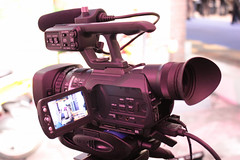 But some of you need real video to support a TV partner. If you use Final Cut Pro and if you need a small camera, the JVC HM100 is a good camera for the size and price. It is around $2800 for the body, maybe $5k with all the trimmings (batteries, cards, mics, wireless, tripods, cases, etc.)
But some of you need real video to support a TV partner. If you use Final Cut Pro and if you need a small camera, the JVC HM100 is a good camera for the size and price. It is around $2800 for the body, maybe $5k with all the trimmings (batteries, cards, mics, wireless, tripods, cases, etc.)
We sometimes partner with photogs from the Sun-Sentinel and they’re mostly using the JVC HM100’s now. They love it because they can just ingest from the card and hand off to their TV folks – they don’t have to edit anything. The editing workflow if you’re Mac-based is great. You can edit right off the cards with Final Cut Pro. But it’s high-def so you still have to deal with render times. The JVC camera doesn’t lend itself to easy manual control so everyone ends up shooting in auto. The zoom is pretty short – only 10x, I think, so it’s not very good for long-throw press conferences or distant spot news. Battery life is poor compared to the competition. The image stabilization is really poor so it doesn’t do well hand-held. But it’s tiny, reasonably well-built, gives a pretty good image, and is lower-priced compared to other video cameras.
 However, if you have high-end video folks who are solely dedicated to doing video, get them a better camera. Sony EX1r or the new Canon XF300 if you have the budget, otherwise the tape cameras – either the Sony Z5U or the Canon XHA1S. Tapeless is not the be-all and end-all… if you’re working only for the web and don’t need to broadcast high-def, the ability to down-convert to SD when you capture tape will really reduce your overall work time. Render times are reduced to almost nothing and there is no time spent on archiving. If you’re Final Cut Pro based, get the Canon, which has the bonus of being able to take analog in, so you can record pool feeds right into the camera. If you’re PC based, get the Sony and the optional flash card memory recording unit, which will let you skip the capture part – but I’m told it doesn’t play so well with Final Cut.
However, if you have high-end video folks who are solely dedicated to doing video, get them a better camera. Sony EX1r or the new Canon XF300 if you have the budget, otherwise the tape cameras – either the Sony Z5U or the Canon XHA1S. Tapeless is not the be-all and end-all… if you’re working only for the web and don’t need to broadcast high-def, the ability to down-convert to SD when you capture tape will really reduce your overall work time. Render times are reduced to almost nothing and there is no time spent on archiving. If you’re Final Cut Pro based, get the Canon, which has the bonus of being able to take analog in, so you can record pool feeds right into the camera. If you’re PC based, get the Sony and the optional flash card memory recording unit, which will let you skip the capture part – but I’m told it doesn’t play so well with Final Cut.
I’m not a fan of AVCHD cameras… you’ve got conversion time on the front end and archive time on the back end. But the size and price might make up for the hassle. For low budgets, the $600 Vixia cameras can’t be beat at the price, if you can live with the AVCHD workflow.
For the still cameras, I recommend the Sennheiser MKE400 mini shotgun mic and a Sennheiser wireless mic. Using either one straight into the camera will work fine for nat sound. For more serious audio, skip the xlr adapter and get a Zoom H4N audio recorder (for interviews, music, and press conferences) and teach people to synch up the sound afterwards or to shoot video like it was a Soundslide, with an un-synched audio track. Get an Electro Voice RE50 interview mic for the Zoom, along with the shotgun and wireless lav. Everyone who shoots video should have an RE50 – it’s the most useful mic you can have.
For tripods, skip the Manfrottos, bite the bullet, and get Sachtlers. They’re pro and will last.
Get the reporters a Kodak Zi8 and a $30 wired Audio Technica lavalier mic and a tabletop tripod. Cheap and good enough.

